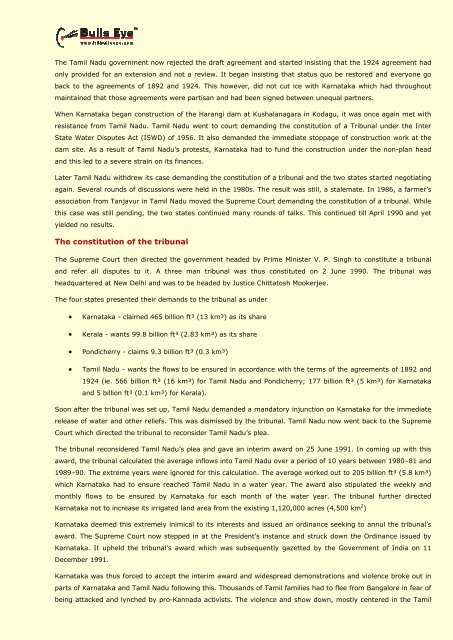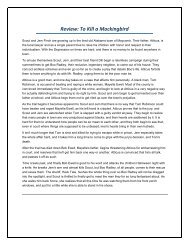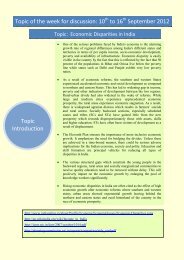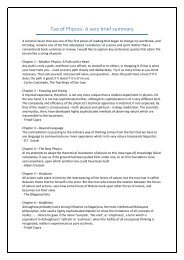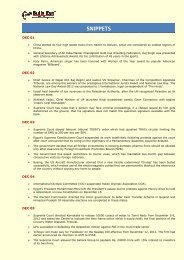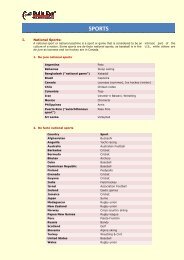KAVERI/CAUVERY WATER DISPUTE - Bulls Eye
KAVERI/CAUVERY WATER DISPUTE - Bulls Eye
KAVERI/CAUVERY WATER DISPUTE - Bulls Eye
You also want an ePaper? Increase the reach of your titles
YUMPU automatically turns print PDFs into web optimized ePapers that Google loves.
The Tamil Nadu government now rejected the draft agreement and started insisting that the 1924 agreement had<br />
only provided for an extension and not a review. It began insisting that status quo be restored and everyone go<br />
back to the agreements of 1892 and 1924. This however, did not cut ice with Karnataka which had throughout<br />
maintained that those agreements were partisan and had been signed between unequal partners.<br />
When Karnataka began construction of the Harangi dam at Kushalanagara in Kodagu, it was once again met with<br />
resistance from Tamil Nadu. Tamil Nadu went to court demanding the constitution of a Tribunal under the Inter<br />
State Water Disputes Act (ISWD) of 1956. It also demanded the immediate stoppage of construction work at the<br />
dam site. As a result of Tamil Nadu’s protests, Karnataka had to fund the construction under the non-plan head<br />
and this led to a severe strain on its finances.<br />
Later Tamil Nadu withdrew its case demanding the constitution of a tribunal and the two states started negotiating<br />
again. Several rounds of discussions were held in the 1980s. The result was still, a stalemate. In 1986, a farmer’s<br />
association from Tanjavur in Tamil Nadu moved the Supreme Court demanding the constitution of a tribunal. While<br />
this case was still pending, the two states continued many rounds of talks. This continued till April 1990 and yet<br />
yielded no results.<br />
The constitution of the tribunal<br />
The Supreme Court then directed the government headed by Prime Minister V. P. Singh to constitute a tribunal<br />
and refer all disputes to it. A three man tribunal was thus constituted on 2 June 1990. The tribunal was<br />
headquartered at New Delhi and was to be headed by Justice Chittatosh Mookerjee.<br />
The four states presented their demands to the tribunal as under<br />
• Karnataka - claimed 465 billion ft³ (13 km³) as its share<br />
• Kerala - wants 99.8 billion ft³ (2.83 km³) as its share<br />
• Pondicherry - claims 9.3 billion ft³ (0.3 km³)<br />
• Tamil Nadu - wants the flows to be ensured in accordance with the terms of the agreements of 1892 and<br />
1924 (ie. 566 billion ft³ (16 km³) for Tamil Nadu and Pondicherry; 177 billion ft³ (5 km³) for Karnataka<br />
and 5 billion ft³ (0.1 km³) for Kerala).<br />
Soon after the tribunal was set up, Tamil Nadu demanded a mandatory injunction on Karnataka for the immediate<br />
release of water and other reliefs. This was dismissed by the tribunal. Tamil Nadu now went back to the Supreme<br />
Court which directed the tribunal to reconsider Tamil Nadu’s plea.<br />
The tribunal reconsidered Tamil Nadu’s plea and gave an interim award on 25 June 1991. In coming up with this<br />
award, the tribunal calculated the average inflows into Tamil Nadu over a period of 10 years between 1980–81 and<br />
1989–90. The extreme years were ignored for this calculation. The average worked out to 205 billion ft³ (5.8 km³)<br />
which Karnataka had to ensure reached Tamil Nadu in a water year. The award also stipulated the weekly and<br />
monthly flows to be ensured by Karnataka for each month of the water year. The tribunal further directed<br />
Karnataka not to increase its irrigated land area from the existing 1,120,000 acres (4,500 km 2 )<br />
Karnataka deemed this extremely inimical to its interests and issued an ordinance seeking to annul the tribunal’s<br />
award. The Supreme Court now stepped in at the President’s instance and struck down the Ordinance issued by<br />
Karnataka. It upheld the tribunal’s award which was subsequently gazetted by the Government of India on 11<br />
December 1991.<br />
Karnataka was thus forced to accept the interim award and widespread demonstrations and violence broke out in<br />
parts of Karnataka and Tamil Nadu following this. Thousands of Tamil families had to flee from Bangalore in fear of<br />
being attacked and lynched by pro-Kannada activists. The violence and show down, mostly centered in the Tamil


